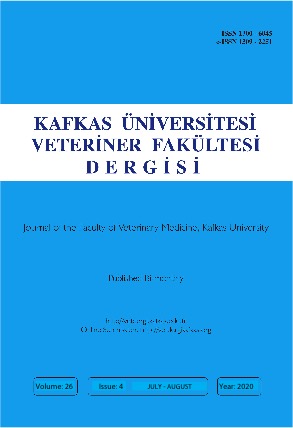
This journal is licensed under a Creative Commons Attribution-NonCommercial 4.0 International License
Kafkas Üniversitesi Veteriner Fakültesi Dergisi
2020 , Vol 26 , Issue 4
Histologic and Electromyographic Evaluation of Neuroregenerative Effect of Stromal Vascular Fraction Following Neuroanastomosis
1Department of Surgery, Faculty of Veterinary Medicine, Bursa Uludag University, TR-16059 Bursa - TURKEY2Department of Histology and Embriology, Faculty of Veterinary Medicine, Bursa Uludag University, TR-16059 Bursa - TURKEY
3Department Neurosurgery, Faculty of Medicine, Bursa Uludag University, TR-16059 Bursa - TURKEY DOI : 10.9775/kvfd.2019.23576 In this study, histologic and electromyographic (EMG) evaluation of neuroregenerative effect of stromal vascular fraction (SVF) following periferal nerve anastomosis was aimed. Totally, 31 Wistar Albino, male rats (weighing about 300 g) were studied, and these rats were grouped according to surgical techniques performed on the right sciatic nerve: group I (GRI) micro suture (n=7), group II (GRII) micro suture + SVF (n=7), group III (GRIII) fibrin glue (n=7) and group IV (GRIV) fibrin glue + SVF (n=7). Fat tissue was taken from 3 rats to prepare SVF, and SVF was produced by non-enzymatic method. The left sciatic nerve of all rats was evaluated for EMG as control. Under general anesthesia, after transversal incision of the sciatic nerve, microsurgical epineural repair technique was performed with 10/0 nonabsorbable suture. EMG examinations were performed in terms of conduction rate, amplitude, distal latency and spontaneous muscle activity at 0th day and postoperative (PO) 1st and 8th weeks. EMG results between and within the groups were statistically evaluated by one-way analysis of variance. Rats in all groups were sacrificed by decapitation at PO 8th week and histological examinations of the sciatic nerves were performed following preparation of the neural tissues. EMG examination results showed the highest nerve conduction in GRI, the highest amplitude in GRIII, normal latency in GRII and longer distal latency in GRIV at PO 8th week. Amplitude and conduction velocity increased gradually in all groups. In needle EMG, the best muscle membrane stabilization was achieved in GRII and GRIV at PO 8th week. Statistically, the values of amplitude, distal latency, conduction velocity, and spontaneous muscle activity were found to be at normal levels at PO 8th week in all groups (P>0.05). In the histological results, although fibroconnective tissue reactions in the anastomosis area had similar scores in GRII and GRIV, maximum fibroconnective tissue reaction and the best axonal regeneration was seen in GRI and GRIII, respectively. In addition, GRI and GRII had the most inflammatory cells accumulation in the suture region, and less inflammatory cells were seen in the anastomosis area of GRIII and GRIV. As a conclusion, fibrin glue presents good electrophysiological and histological results; however, it is clear that local SVF usage on the nerve anastomosis area can be a good choice to decrease fibroconnective tissue reaction and inflammation. Keywords : Electromyography, Histology, Neuroanastomosis, Rat, Stromal vascular fraction










